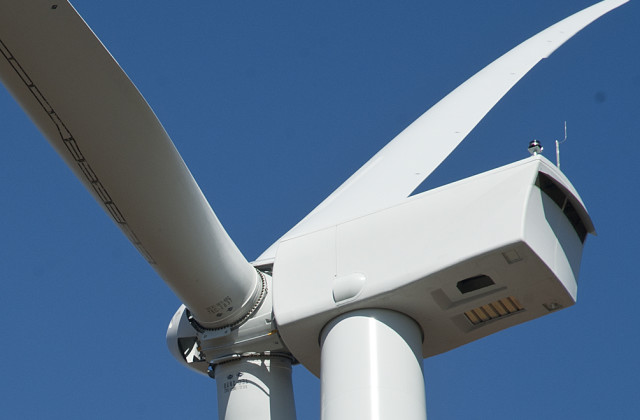A New Turbine Is Planned for Colebrook Site
Projected to be bigger and more powerful than the first two
By Wiley Wood
The two wind turbines that now loom over Route 44 on the way to Winsted, representing Connecticut’s first commercial wind farm, may soon be joined by a third.
BNE Energy, which built the first two in 2015, has applied to the Connecticut Siting Council for more time to build a third. The Council approved the Flagg Hill Road site for three turbines back in 2013, but all construction was to be completed by Sept. 23, 2018. With the deadline fast approaching, BNE Energy has petitioned the Siting Council for a three-year extension.
First Selectman Tom McKeon of Colebrook confirmed that a third turbine was in the works, adding that the Town of Colebrook has no say in the matter because the Siting Council has already given its approval.
At a hearing on August 2, BNE Energy reported to the Council that, in June 2017, it entered into a new power purchase agreement with Eversource Energy for the projected third turbine. However, it needed more time “to complete preliminary activities, finalize the interconnection agreement, and construct the third turbine.”
When asked for a more detailed explanation, an attorney for BNE Energy responded that there were still permitting requirements to fullfill, including the submittal of a modified Development and Management (D&M) Plan to the Siting Council. Once the permitting has fallen into place, BNE will seek to complete its financing.
Originally, the Council approved a plan for three General Electric 2.85 megawatt turbines on the Flagg Hill site. The new turbine, as described in the 2017 agreement with Eversource, will have a generating capacity of 3.8 megawatts, making it larger than the other two, with a rotor diameter of 130 meters. The existing turbines have a rotor diameter of 100 meters.
When BNE Energy calculated shadow flicker, noise and ice throw in its report for the Siting Council, it based its figures on the 1.6 megawatt turbine it initially expected to install, according to Joyce Hemingson of FairwindCT, a citizens’ group that opposed the wind farm, and the Siting Council accepted the figures as applying to the 2.85 megawatt turbines that were eventually substituted for the smaller ones.
In its latest agreement with Eversource, BNE Energy has agreed to sell the power generated by the third turbine at about half the rate negotiated in the earlier power purchase agreement.
“Hard to figure,” said Hemingson by email. She noted that BNE Energy recently petitioned the state’s Public Utilities Regulatory Authority to reopen the earlier purchase agreement and raise the rate at which it sells electricity to the utility by 25 percent, citing higher costs and lower revenues than expected. So far, PURA has not responded to the request.
The two existing turbines are assessed by the Town of Colebrook at $9.3 million, over 5 percent of the town’s taxable property, and generate about $286,000 a year in town taxes. However, BNE Energy has brought a suit against Colebrook, charging that the assessment of the turbines is “manifestly excessive.” A series of pretrial hearings over the last two years at the tax appeals court in New Britain has brought no resolution, and the case is now headed for trial in Litchfield Superior Court.
To increase the share of Connecticut’s electricity generated by renewable and clean sources, the state’s Department of Energy and Environmental Protection awarded its first offshore wind project to Deepwater Wind in June 2018 for a 200-megawatt installation in the waters between Montauk, N.Y. and Martha’s Vineyard. DEEP also awarded two fuel cell projects totaling 44 megawatts to two Connecticut-based companies.
In 2011, BNE Energy told the Siting Council that its two turbines on the Flagg Hill site would annually generate at least 12,614 megawatt hours of Class I renewable energy, which would require the combustion of 21,069 barrels of oil to generate by conventional means. According to BNE Energy’s quarterly generation reports to PURA, the Colebrook wind farm has met and even slightly exceeded that level of energy generation in the past two years, with 12,742 MWh generated in 2016 and 12,706 MWh in 2017. The wind farm, according to these figures, is operating at about 30 percent of its rated capacity.
On Aug. 30, the Siting Council granted BNE Energy’s motion for a three-year extension.
Photo, top, of one of the GE 2.85 megawatt towers on the Flagg Hill site in Colebrook, by Bruce Frisch.
Correction: An earlier version of this article incorrectly referred to the citizens’ group “FairwindsCT.” The correct name is “FairwindCT.”

